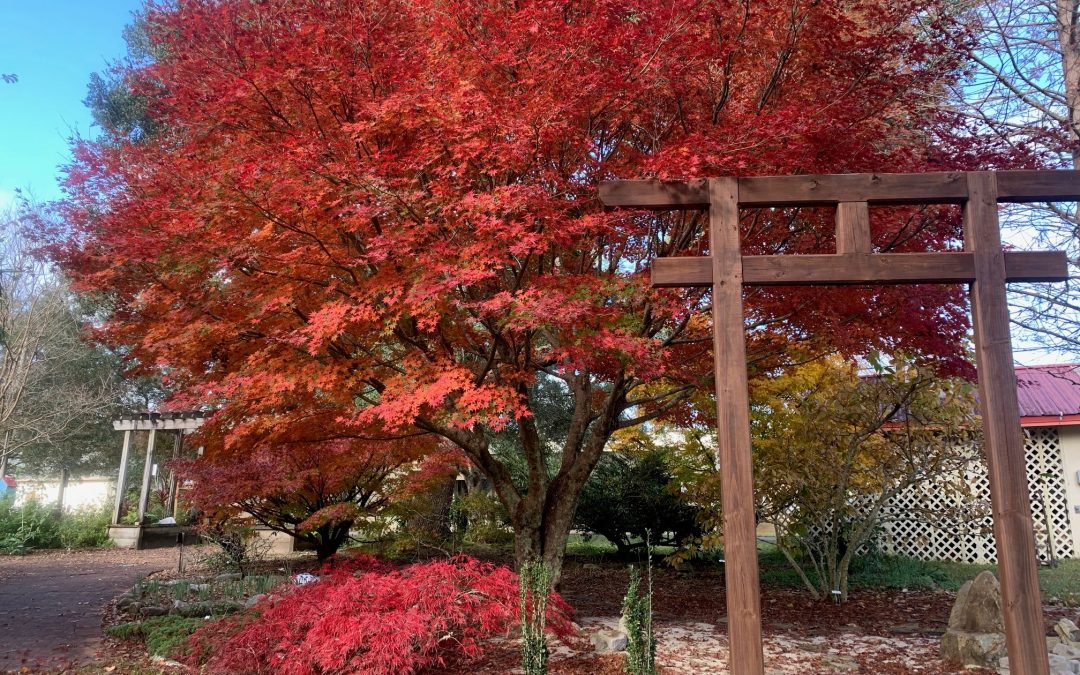
by Beth Bolles | Dec 13, 2024
When looking for a small tree that provides a visual impact in the landscape, nothing beats a Japanese maple.
In North Florida, we have landscapes with some suitable conditions for growing a Japanese maple but these trees are not for every site. Japanese Maple plants prefer some shade, especially in the afternoon, and protection from winds. If you have a high tree canopy that allows for filtered sun throughout the day, many cultivars will grow well with this light. Soils should be moist but well drained with good organic matter. Areas with higher pH soils such as home foundations or around concrete patios usually show plants with poorer growth and nutrient issues.
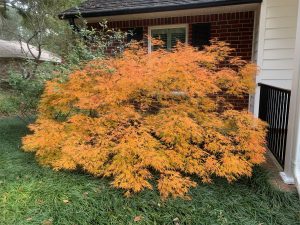
This specimen is suited to its spot with acid soil with a high Live oak tree canopy. The fall color is beautiful. Photo by Beth Bolles, UF IFAS Extension Escambia County.
Many people love the leaf color of Japanese maples, either burgundy leaf forms or selections with beautiful fall color. The palmate leaf shape also adds interest, along with varying degrees of coarse to finer textures.
My favorite characteristic of the Japanese maple is the growth form. Trees often have a layered appearance with branches extending outward, making a beautiful small canopy. Many selections have smooth bark but one cultivar, the Pine bark maple, has plated bark that looks like a pine tree.

Pine bark Japanese maple form and fall leaf color. Photo by Beth Bolles, UF IFAS Extension Escambia County.
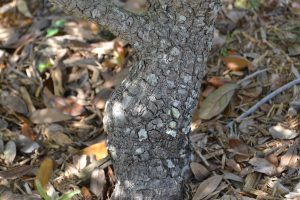
Interesting bark of the Pine bark maple. Photo by Beth Bolles, UF IFAS Extension Escambia County.
Although the growth rate is slow to moderate, be sure to research the plant size of the cultivar you want. There are small tree forms that will reach an average of 20 feet and plants that only grow about 5 feet in twenty years. Our cool season is the best time to plant a Japanese maple if your landscape is suited for this tree.
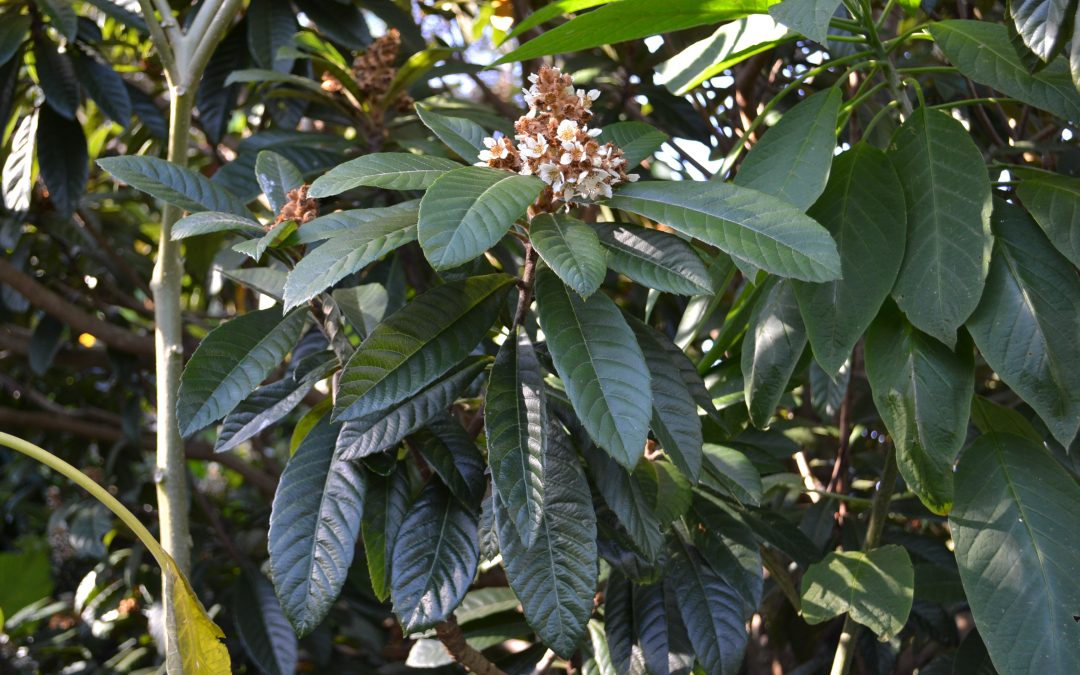
by Beth Bolles | Nov 13, 2024
Although not native to Florida, the Loquat or Japanese plum is adapted to North Florida conditions. Unlike its relatives, apple, peach, and pear, the loquat is an evergreen tree providing a tropical look with attractive dark green leaves.
Flowers appear in Fall and are pollinated by many insects. Orange fruits are ready for harvest in spring if temperatures have not been too cold.
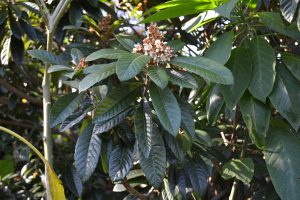
Bees will visit loquat flowers in the fall. Photo by Beth Bolles, UF IFAS Extension Escambia County.
Loquat trees can reach 20 to 25 feet in height with a good spread. Seedling trees will produce fruit but improved flavors are available with different cultivars.
One of the loquats in the Escambia County Demonstration garden was damaged by a hard freeze and succumbed to a secondary bark beetle attack the following spring. The 2nd tree is thriving as a key feature in the tropical garden. The downside to the location of our tree is that is surrounded by informal walkways that can get messy from fruit that falls in the spring. This may be a consideration when you install your own loquat tree.
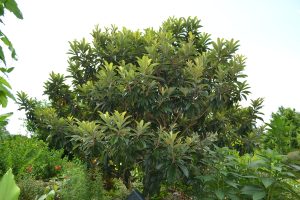
Loquat at Escambia Extension. Photo by Beth Bolles, UF IFAS Extension Escambia County
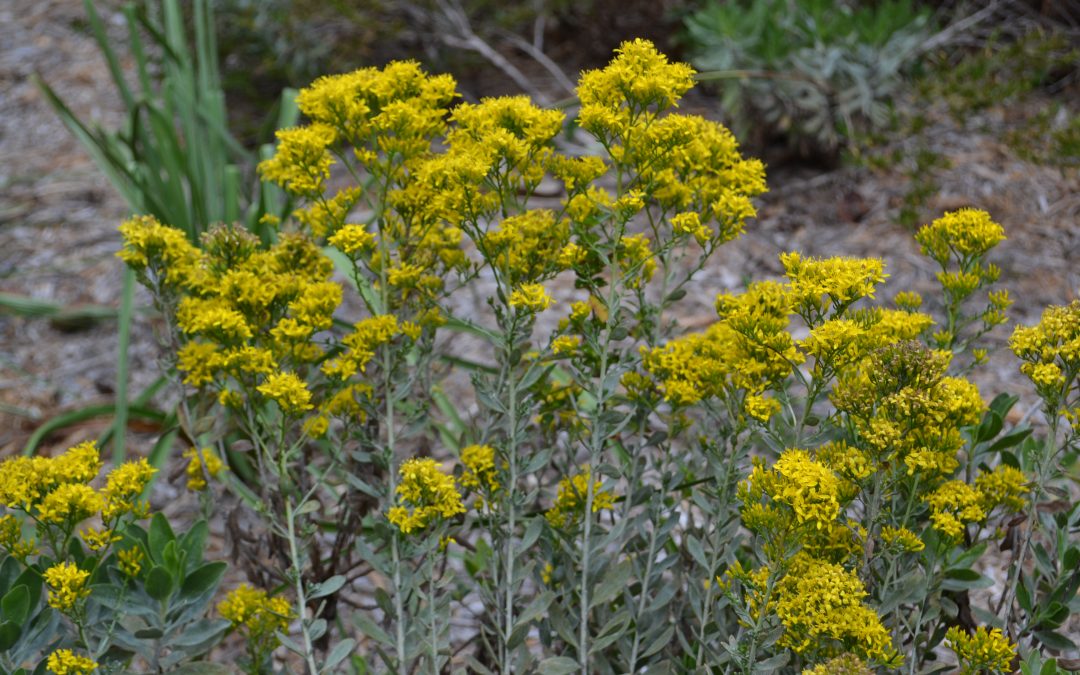
by Beth Bolles | Oct 24, 2024
If you love wildflowers, the Fall season has so many plants for you to enjoy. We often think of wildflowers as those in natural settings, on roadsides, or in drainage spots. Here are a few wildflowers that make excellent landscape additions.
Goldenrods (Solidago spp.) are everywhere and the yellow blooms are stunning. If all the incorrect information about goldenrod as an allergy causing plant never existed (ragweed is the main culprit), we would see selections of goldenrod available in every commercial outlet. Many selections have an upright growth so add goldenrod against fences, in back of borders, or large clumps in sunny areas of your landscape.
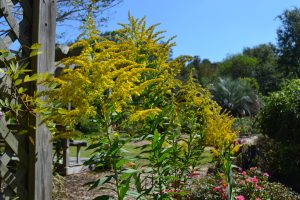
Goldenrod as a landscape feature at Escambia Demonstration Garden. Photo by Beth Bolles, UF IFAS Extension Escambia County
If you have a moist area and love purple, Mistflower (Conoclinium coelestinum) makes a wonderful fall blooming feature. Plants will colonize an area with running stems so it tends to form a large clump in moist soils. You may notice this in ditches on a drive around your county. The clusters of flowers look fluffy and will be present for many weeks in both full sun or partial shade.
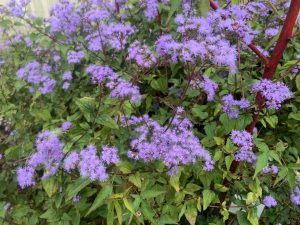
A clump of mistflower in a moist plant bed. Photo by Beth Bolles, UF IFAS Extension Escambia County
For dry and well drained spots of your landscape, the Woody goldenrod (Chrysoma pauciflosculosa) is a good choice. The small shrub offers bright yellow fall flowers that extend above a 2 foot tall plant. Plants tend to be evergreen when in the right location and additional new seedlings will emerge each spring if your landscape is suited for this plant.
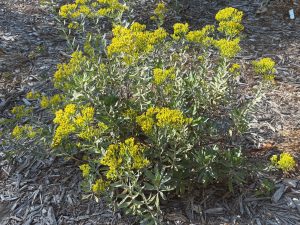
Woody goldenrod in a home landscape. Photo by Beth Bolles, UF IFAS Extension Escambia County
For those enhancing a butterfly garden, add Purple false foxglove (Agalinis purpurea), a host plant to the Buckeye butterfly. Plants grow well in our acidic well drained soils with a little moisture. Numerous tubular pink flowers occur in the Fall until a frost. Plants reseed well.
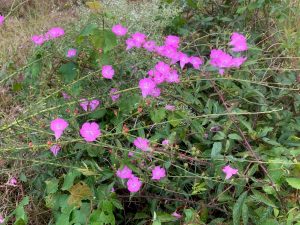
The Purple False Foxglove with vivid pink blooms in a natural setting. Photo by Beth Bolles, UF IFAS Extension Escambia County
If you love all the colors and variety of wildflowers, it is a good time for finding seeds and plants to grow your own. Native nurseries and online retailers carry a wide selection for all seasons and many are low maintenance enhancements for our home landscapes. Like any other ornamental or grass, be sure to match the wildflower with your specific growing conditions.
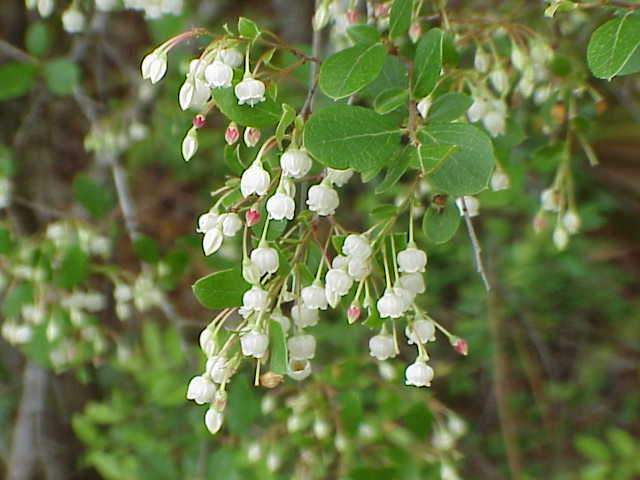
by Beth Bolles | Oct 17, 2024
UF IFAS Extension Escambia County was recently able to offer a native tree and shrub giveaway to our community. A county partner had some grant funding remaining and chose a nice selection of plants grown by a local native nursery. After seeing the plant selection, I was really excited that a few participating homeowners had the opportunity to take home one of my favorite native plants, the Sparkleberry, Vaccinium arboretum.
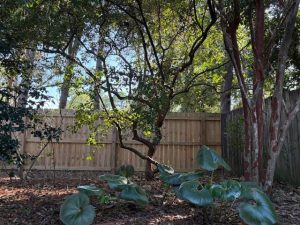
The Sparkleberry in the corner of my back yard. Photo by Beth Bolles, UF IFAS Extension Escambia County
Twenty-three years ago, I saved a sparkleberry on my new home lot because I loved this native tree. It has interest in all seasons in my opinion, including flowers, small fruit for wildlife, attractive bark, and an interesting shape as it matures. It has been a slower growing tree than others in my yard but I have enjoyed watching the tree develop its form and the bark develop the beautiful flaky cinnamon-brown look.
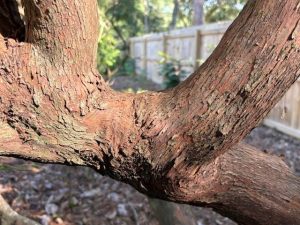
Sparkleberry bark and structure are attractive features in the landscape. Photo by Beth Bolles, UF IFAS Extension Escambia County.
The small tree is now about 12 feet tall and has never had any issues in the sandy, well drained soil. It can tolerate some moisture as long as the soil drains well. A grouping of trees from my neighbor’s lot keeps the plant in partial shade and we can often find sparkleberry specimens in the filtered light of woods. It can tolerate a sunnier location if that is the spot you have available for a small tree.
In addition to our enjoyment of this native tree, pollinators and other animals will appreciate the flower nectar, pollen, and berries. If you have a native nursery close to your home, be sure to ask for your own Sparkleberry if your site is suitable.
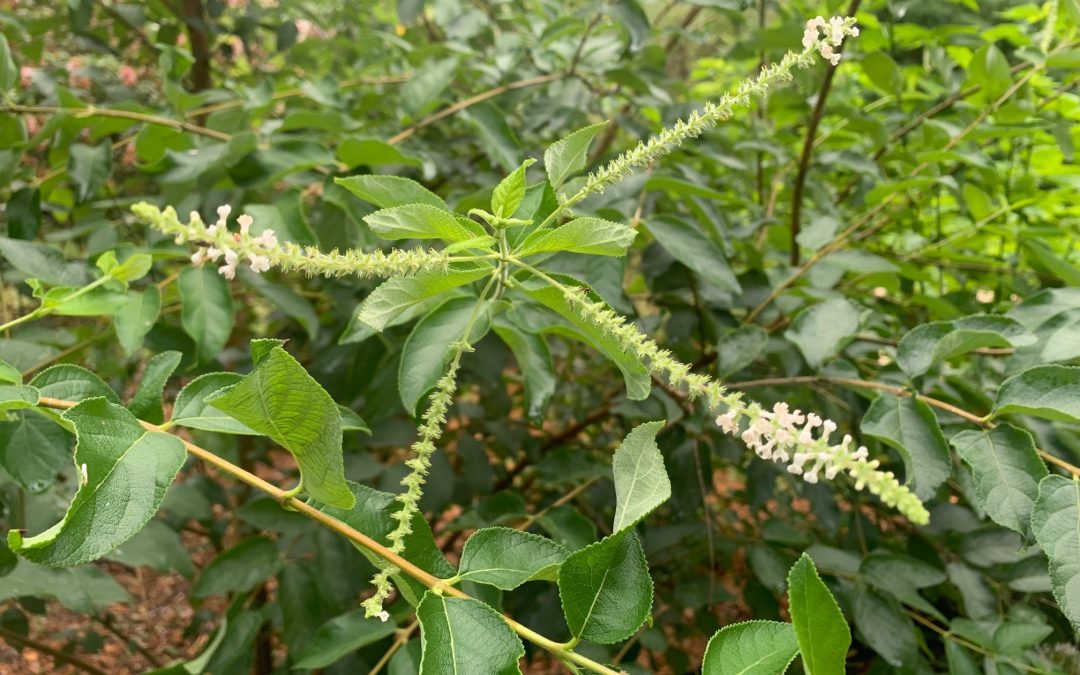
by Beth Bolles | Sep 4, 2024
Two years ago, the Escambia Master Gardener Volunteers were gifted with the flowering perennial Sweet Almond bush (Aloysia virgata). It has quickly become a favorite plant of volunteers and garden visitors due to its many attractive features.
Although, Sweet almond bush is not a Florida native, it is Florida-friendly plant for zones 8b -10b. Plants grow very large, from 6-10 feet with branching that can spread out in all directions. In North Florida, plants can be damaged by a freeze but either return from the base or from growing points higher on branches.
One of the best features are the fragrant white flowers spikes that will be present late spring through fall. Many types of pollinating insects will be attracted to the flowers, although sometimes flowers are too high on the plant for many of us to get a good look at pollinator details.
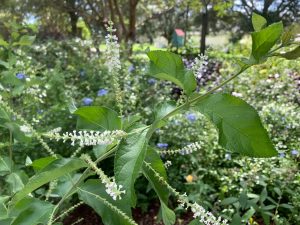
Sweet almond bush blooms. Photo by Beth Bolles, UF IFAS Extension Escambia County
We have plants both in full sun and partial shade that are performing well in the Escambia Demonstration Gardens. Plants do receive water when rainfall is lacking for about 5-7 days (or all of August this year in the Northwest Panhandle). You can shape your plant with a little light pruning during the growing season to keep branches a little more in bounds. Don’t forget to start a few new plants from these cuttings and then share a low maintenance plant with your neighbors.

















